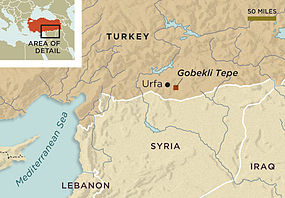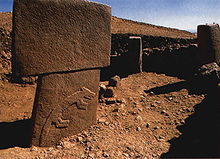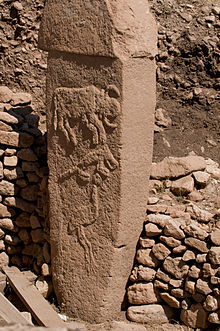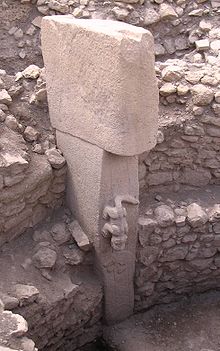Göbekli Tepe
| Göbekli Tepe | |
 |
|
| Location | near Şanlıurfa |
|---|---|
| Region | Southeastern Anatolia Region, Turkey |
| Coordinates | 37°13′24″N 38°55′21″E / 37.2233°N 38.9224°ECoordinates: 37°13′24″N 38°55′21″E / 37.2233°N 38.9224°E |
| Type | Temple |
| History | |
| Periods | pre-pottery Neolithic B |
| Site notes | |
| Condition | well preserved |
| Website | references: [1] Megalithic Portal |
Göbekli Tepe Turkish: [ɡøbe̞kli te̞pɛ][2] ("Potbelly Hill"[3]) is a Neolithic hilltop sanctuary erected at the top of a mountain ridge in the Southeastern Anatolia Region of Turkey, some 15 kilometers (9 mi) northeast of the town of Şanlıurfa (formerly Urfa / Edessa). It is the oldest known human-made religious structure.[1][4] The site was most likely erected by hunter-gatherers in the 10th millennium BC and has been under excavation since 1994 by German and Turkish archaeologists.[5] Together with Nevalı Çori, it has revolutionized understanding of the Eurasian Neolithic.[6]
Contents |
[edit] Discovery
Göbekli Tepe is located in southeastern Turkey. It was first noted in a survey conducted by Istanbul University and the University of Chicago in 1964, which recognized that the hill could not entirely be a natural feature and postulated that a Byzantine cemetery lay beneath. The survey noted a large number of flints and the presence of limestone slabs thought to be Byzantine grave markers. In 1994, archaeologist Klaus Schmidt of the German Archaeological Institute of Istanbul visited the site and recognized that it was in fact a much older Neolithic site. Since 1995[7] excavations have been conducted by the German Archaeological Institute of Istanbul and the Şanlıurfa Museum, under the direction of Schmidt (University of Heidelberg 1995–2000, German Archaeological Institute 2001-present). Prior to excavation the hill had been under agricultural cultivation. Generations of local inhabitants had frequently moved rocks and placed them in clearance piles and much archaeological evidence may have been destroyed in the process. Scholars from the Hochschule Karlsruhe began documenting the architectural remains and soon discovered T-shaped pillars facing south east. Some of these pillars had apparently undergone attempts at destruction, probably by farmers who mistook them for ordinary large rocks.[8]
[edit] The complex
Göbekli Tepe is the oldest known man-made religious structure.[4] The site, located on a hilltop, contains 20 round structures which had been buried, four of which have been excavated. Each round structure has a diameter of between 10 and 30 meters (30 and 100 ft) and all are decorated with massive, mostly T-shaped, limestone pillars that are the most striking feature of the site. The limestone slabs were quarried from bedrock pits located around 100 meters (330 ft) from the hilltop, with neolithic workers using flint points to carve the bedrock.[9] The majority of flint tools found at the site are Byblos and Nemrik points. That neolithic people with such primitive flint tools quarried, carved, transported uphill, and erected these massive pillars has astonished the archaeological world, and must have required a staggering amount of manpower and labor.[10]
Two pillars are at the center of each circle, possibly intended to help support a roof, and up to eight pillars are evenly positioned around the walls of the room. The spaces between the pillars are lined with unworked stone and there are stone benches between each set of pillars around the edges of the wall.[11]
Many of the pillars are decorated with carved reliefs of animals and of abstract enigmatic pictograms. The pictograms may represent commonly understood sacred symbols, as known from Neolithic cave paintings elsewhere. The reliefs depict lions, bulls, boars, foxes, gazelles, donkeys, snakes and other reptiles, insects, arachnids, and birds, particularly vultures. (At the time the shrine was constructed, the surrounding country was much lusher and capable of sustaining this variety of wildlife, before millennia of settlement and cultivation resulted in the near–Dust Bowl conditions prevailing today.)[8] Vultures also feature prominently in the iconography of the Neolithic sites of Çatalhöyük and Jericho; it is believed that in the early Neolithic culture of Anatolia and the Near East the deceased were deliberately exposed in order to be excarnated by vultures and other carrion birds. (The head of the deceased was sometimes removed and preserved—possibly a sign of ancestor worship.)[12] This, then, would represent an early form of sky burial, as practiced today by Tibetan Buddhists and by Zoroastrians in India.[13]
Few humanoid figures have surfaced at Göbekli Tepe, but they include the engraving of a naked woman posed frontally in a crouched position that Schmidt likens to the Venus accueillante figures found in Neolithic north Africa, and a decapitated corpse surrounded by vultures in bas-relief. Some of the T-shaped pillars picture human arms, which indicate that they represent the bodies of stylized humans (or anthropomorphic gods). The wider stone member atop the T-shaped pillars is thought to symbolize the head; thus the pillars as a whole have an anthropomorphic identity.[14] One example is decorated with human hands in what could be interpreted as a prayer gesture, with a simple stole or surplice engraved above; this may be intended to signify a temple priest.[15]
Until excavations began, a complex on this scale was not thought possible for a community so ancient, and with such primitive quarrying tools. The massive sequence of stratification layers suggests several millennia of activity, perhaps reaching back to the Mesolithic. The oldest occupation layer (Layer III) contains monolithic pillars linked by coarsely built walls to form circular or oval structures. Four such buildings have been uncovered, with diameters between 10–30 meters (33–98 ft). Geophysical surveys indicate the existence of 16 additional structures.
Layer II, dated to Pre-Pottery Neolithic B (PPNB) (7500–6000 BC), has revealed several adjacent rectangular rooms with floors of polished lime, reminiscent of Roman terrazzo floors. The most recent layer consists of sediment deposited as the result of agricultural activity.
[edit] Dating
The PPN A settlement has been dated to c. 9000 BC. There are remains of smaller houses from the PPN B and a few epipalaeolithic finds as well.
There are a number of radiocarbon dates (presented with one standard deviation errors and calibrations to BC):
| Lab-Number | Date BP | Cal BC | Context |
|---|---|---|---|
| Ua-19561 | 8430 ± 80 | 7560–7370 | enclosure C |
| Ua-19562 | 8960 ± 85 | 8280–7970 | enclosure B |
| Hd-20025 | 9452 ± 73 | 9110–8620 | Layer III |
| Hd-20036 | 9559 ± 53 | 9130–8800 | Layer III |
The Hd samples are from charcoal in the lowest levels of the site and would date the active phase of occupation. The Ua samples come from pedogenic carbonate coatings on pillars and only indicate a time after the site was abandoned—the terminus ante quem.[16]
[edit] Architecture
The structures are round megalithic buildings. The walls are made of unworked dry stone and include numerous T-shaped monolithic pillars of limestone that are up to 3 meters (10 ft) high. Another, bigger pair of pillars is placed in the centre of the structures. There is evidence that the structures were roofed; the central pair of pillars may have supported the roof. Some of the floors are made of terrazzo (burnt lime), others are bedrock from which pedestals for the large pair of central pillars were carefully carved in high relief.[17]
The reliefs on the pillars include foxes, lions, cattle, hyenas, wild boar, wild asses, cranes, ducks, scorpions, ants, spiders, many snakes, and a small number of anthropomorphic figures. Some of the reliefs have been deliberately erased, maybe in preparation for new designs. There are freestanding sculptures as well that may represent wild boars or foxes. As they are heavily encrusted with lime, it is sometimes difficult to tell. Comparable statues have been discovered at Nevalı Çori and Nahal Hemar.
The quarries for the statues are located on the plateau itself; some unfinished pillars have been found there in situ. The biggest unfinished pillar is still 6.9 meters (22.6 ft) long; a length of 9 meters (30 ft) has been reconstructed. This is much larger than any of the finished pillars found so far. The stone was quarried with stone picks.[citation needed] Bowl-like depressions in the limestone rocks may already have served as mortars or fire-starting bowls in the epipalaeolithic. There are some phalloi and geometric patterns cut into the rock as well; their dating is uncertain.
Creation of the circular enclosures in layer III later gave way to the construction of small rectangular rooms in layer II. But the T-shaped pillars, the main feature of the older enclosures, survived, indicating that the buildings of Layer II likewise served as sanctuaries.[18] Schmidt believes this "cathedral on a hill" was a pilgrimage destination attracting worshipers up to a 100 miles (160 km) distant. Butchered bones found in large numbers from local game such as deer, gazelle, pigs, and geese have been identified as refuse derived from hunting and food prepared for the congregants.[19]
The site was deliberately backfilled sometime after 8000 BC: the buildings are covered with debris, mostly flint gravel, stone tools, and animal bones, which must have been brought from elsewhere.[20] The lithic inventory is characterised by Byblos points and numerous Nemrik-points. There are Helwan-points and Aswad-points as well.
[edit] Economy
While the site formally belongs to the earliest Neolithic (PPNA), up to now no traces of domesticated plants or animals have been found. The inhabitants are assumed to have been hunters and gatherers who nevertheless lived in villages for at least part of the year.[21] Schmidt speculates that the site played a key function in the transition to agriculture; he assumes that the necessary social organization needed for the creation of these structures went hand-in-hand with the organized domestication of wild crops. Wild cereals may have been used for sustenance more intensively than before and were perhaps deliberately cultivated. Recent DNA analysis of modern domesticated wheat compared with wild wheat has shown that its DNA is closest in sequence to wild wheat found on Mount Karaca Dağ 20 miles (32 km) away from the site, suggesting that this is where modern wheat was first domesticated.[22]
Schmidt considers Göbekli Tepe a central location for a cult of the dead. He suggests that the carved animals are there to protect the dead. Though no tombs or graves have been found so far, Schmidt believes they remain to be discovered in niches located behind the sacred circles' walls.[8] Schmidt also interprets it in connection with the initial stages of an incipient Neolithic. It is one of several neolithic sites in the vicinity of Mount Karaca Dağ, an area which geneticists suspect may have been the origin of at least some of our cultivated grains (see Einkorn). Such scholars suggest that the Neolithic revolution, i.e., the beginnings of grain cultivation, took place here. Schmidt and others believe that mobile groups in the area were forced to cooperate with each other to protect early concentrations of wild cereals from wild animals (herds of gazelles and wild donkeys). This would have led to an early social organization of various groups in the area of Göbekli Tepe. Thus, according to Schmidt, the Neolithic did not begin on a small scale in the form of individual instances of garden cultivation, but started immediately as a large-scale social organization ("a full-scale revolution.)"[23]
[edit] Chronological context
All statements about the site must be considered preliminary, as only about 5% of the site's total area has yet been excavated. Schmidt believes that the dig could well continue for another fifty years, "and barely scratch the surface."[8] Floor levels have been reached in three of the Layer III enclosures; enclosure B contains a terrazzo-like floor; in enclosures C and D the floors were found to be natural bedrock, carefully smoothed. So far, excavations have revealed very little evidence for residential use. Through the radiocarbon method, the end of Layer III can be fixed at c. 9000 BC (see above); its beginnings are estimated to 11,000 BC or earlier. Layer II dates to about 8000 BC.
Thus, the structures not only predate pottery, metallurgy, and the invention of writing or the wheel; they were built before the so-called Neolithic Revolution, i.e., the beginning of agriculture and animal husbandry around 9000 BC. But the construction of Göbekli Tepe implies organization of an order of complexity not hitherto associated with Paleolithic, PPNA, or PPNB societies. The archaeologists estimate that up to 500 persons were required to extract the heavy pillars from local quarries and move them 100–500 meters (330–1,640 ft) to the site.[24] The pillars weigh 10–20 metric tons (10–20 long tons; 11–22 short tons); with one found still in its quarry weighing 50 tons.[25] It is generally believed that an elite class of religious leaders supervised the work and later controlled whatever ceremonies took place here. If so, this would be the oldest known evidence for a priestly caste—much earlier than such social distinctions developed elsewhere in the Near East.[8]
Around the beginning of the 8th millennium BC "Potbelly Hill" lost its importance. The advent of agriculture and animal husbandry brought new realities to human life in the area, and the "stone-age zoo" (as Schmidt calls it) depicted on the pillars apparently lost whatever significance it had had for the region's older, foraging, communities. But the complex was not simply abandoned and forgotten to be gradually destroyed by the elements. Instead, each enclosure was deliberately buried under as much as 300 to 500 cubic meters (390 to 650 cu yd) of debris consisting mainly of small limestone fragments, stone vessels, and stone tools; many animal, even human bones, are also found in the burial refuse.[26] Why exactly the enclosures were backfilled is unknown, but it preserved them for posterity.
[edit] Interpretation and importance
Göbekli Tepe is regarded as an archaeological discovery of the greatest importance since it could profoundly change our understanding of a crucial stage in the development of human societies. It seems that the erection of monumental complexes was within the capacities of hunter-gatherers and not only of sedentary farming communities as had been previously thought. In other words, as excavator Klaus Schmidt puts it: "First came the temple, then the city."[27]
Not only its large dimensions, but the side-by-side existence of multiple pillar shrines makes the location unique. There are no comparable monumental complexes from its time. Nevalı Çori, a well-known Neolithic settlement also excavated by the German Archaeological Institute and submerged by the Atatürk Dam since 1992, is 500 years later, its T-shaped pillars are considerably smaller, and its shrine was located inside a village; the roughly contemporary architecture at Jericho is devoid of artistic merit or large-scale sculpture; and Çatalhöyük, perhaps the most famous of all Anatolian Neolithic villages, is 2,000 years younger.
Schmidt has engaged in some speculation regarding the belief systems of the groups that created Göbekli Tepe, based on comparisons with other shrines and settlements. He assumes shamanic practices and suggests that the T-shaped pillars may represent mythical creatures, perhaps ancestors, whereas he sees a fully articulated belief in gods only developing later in Mesopotamia, associated with extensive temples and palaces. This corresponds well with an ancient Sumerian belief that agriculture, animal husbandry and weaving had been brought to mankind from the sacred mountain Du-Ku, which was inhabited by Annuna—deities, very ancient gods without individual names. Klaus Schmidt identifies this story as an oriental primeval myth that preserves a partial memory of the emerging Neolithic.[28] It is also apparent that the animal and other images give no indication of organized violence, i.e., there are no depictions of hunting raids or wounded animals, and the pillar carvings ignore game on which the society mainly subsisted, like deer, in favor of formidable creatures such as lions, snakes, spiders and scorpions.[8][29][30]
At present, Göbekli Tepe raises more questions for archaeology and prehistory than it answers. We do not know how a force large enough to construct, augment, and maintain such a substantial complex was mobilized and rewarded or fed in the conditions of pre-Neolithic society. We cannot "read" the pictograms, and do not know for certain what meaning the animal reliefs had for visitors to the site; the variety of fauna depicted, from lions and boars to birds and insects, makes any single explanation problematic. As there seems to be little or no evidence of habitation, and the animals depicted on the stones are mainly predators, the stones may have been intended to stave off evils through some form of magic representation; it is also possible that they served as totems.[31] The assumption that the site was strictly cultic in purpose and not inhabited has also been challenged by the suggestion that the structures served as large communal houses, "similar in some ways to the large plank houses of the Northwest Coast of North America with their impressive house posts and totem poles."[32] It is not known why every few decades the existing pillars were buried to be replaced by new stones as part of a smaller, concentric ring inside the older one.[33] Human burial may or may not have occurred at the site. The reason the complex was eventually backfilled remains unexplained. Until more evidence is gathered, it is difficult to deduce anything certain about the originating culture or the site's significance.
[edit] Conservation
In 2010, Global Heritage Fund (GHF) announced it will undertake a multi-year conservation program to preserve Göbekli Tepe. The first conservation program in the site's history, the partners include Klaus Schmidt and the German Archaeological Institute, German Research Foundation, Şanlıurfa Municipal Government, and the Turkish Ministry of Tourism and Culture.[34] The stated goals of the GHF Göbekli Tepe project are to support the preparation of a Site Management and Conservation Plan, construction of a shelter over the exposed archaeological features, training local community members in guiding and conservation, and helping Turkish authorities secure UNESCO World Heritage Site nomination.[1]
[edit] See also
- Tell Aswad – a c.9000 BC site in Syria.
- List of megalithic sites
[edit] Notes
- ^ a b c "GHF - Gobekli Tepe, Turkey - Overview", globalheritagefund.org: GHF3.
- ^ reference of entry added to Forvo website by User:kubra on 2010-01-13
- ^ "History in the Remaking". Newsweek. Feb 18, 2010.
- ^ a b "The World's First Temple". Archaeology magazine. Nov/Dec 2008. p. 23. http://www.archaeology.org/0811/abstracts/turkey.html.
- ^ http://www.gobeklitepe.info
- ^ Mann, June 2011, p. 39
- ^ "Deutsches Archäoligisches Institut". http://www.dainst.org/en/project/goebeklitepe?ft=all.
- ^ a b c d e f Curry, Andrew (November 2008). "Göbekli Tepe: The World’s First Temple?". Smithsonian Institution. http://www.smithsonianmag.com/history-archaeology/30706129.html. Retrieved 2009-03-14.
- ^ Schmidt 2000b, pp. 52–53
- ^ Mithen 2004, p. 66
- ^ Mithen 2004, p. 65
- ^ Mithen 2004, pp. 93–96.
- ^ Peters & Schmidt 2004, p. 214
- ^ Schmidt 2010, pp. 244, 246.
- ^ Schmidt 2006, 232–8, 261–4.
- ^ Upper Mesopotamia (SE Turkey, N Syria and N Iraq) 14C databases: 11th–6th millennia cal BC
- ^ Schmidt, 2010, p. 251.
- ^ Schmidt 2010, pp. 239, 241.
- ^ Peters & Schmidt 2004, 207
- ^ Schmidt 2010, p. 242
- ^ The Guardian report 23 April 2008
- ^ Heun et al., Site of Einkorn Wheat Domestication Identified by DNA Fingerprinting, Science, 278 (1997) 1312–14.
- ^ Klaus-Dieter Linsmeier: Eine Revolution im großen Stil. Interview mit Klaus Schmidt. In: Abenteuer Archäologie. Kulturen, Menschen, Monumente. Spektrum der Wissenschaft, Heidelberg 2006, 2, ISSN 1612-9954
- ^ "Which came first, monumental building projects or farming?". Archaeo News. 14 December 2008. http://www.stonepages.com/news/archives/003061.html.
- ^ Taracha, Piotr (2009). Religions of second millennium Anatolia. Eisenbrauns. p. 12. ISBN 978-3-447-05885-8. http://books.google.co.uk/books?id=xTE7o8aKI7IC&pg=PA12&dq=%22G%C3%B6bekli+Tepe%22+%2250+tons%22#v=onepage&q&f=false.
- ^ Schmidt 2010, pp. 242—243, 249.
- ^ K. Schmidt 2000: “Zuerst kam der Tempel, dann die Stadt.”
- ^ Schmidt 2006, pp. 216–221
- ^ Schmidt 2006, pp. 193–4; 218.
- ^ Peters & Schmidt 2004, p. 209
- ^ Peters & Schmidt 2004: pp. 209–212
- ^ Banning 2011
- ^ Mann, June 2011, p. 48
- ^ "GHF - Gobekli Tepe - Turkey", globalheritagefund.org, web: GHF2.
[edit] References
- Badisches Landesmuseum Karlsruhe (ed.): Vor 12.000 Jahren in Anatolien. Die ältesten Monumente der Menschheit. Begleitbuch zur Ausstellung im Badischen Landesmuseum vom 20. Januar bis zum 17. Juni 2007. Theiss, Stuttgart 2007, ISBN 978-3-8062-2072-8
- E.B. Banning, "So Fair a House: Göbekli Tepe and the Identification of Temples in the Pre-Pottery Neolithic of the Near East", Current Anthropology, 52.5 (October 2011), 619 ff.: http://www.scribd.com/doc/67961270/Gobekli-Tepe-temples-Ted-Banning-2011
- Andrew Curry, "Seeking the Roots of Ritual," Science 319 (18 January 2008), pp. 278–80: http://80.251.40.59/veterinary.ankara.edu.tr/fidanci/Yasam/Gelecege_Miras/Gobekli-Tepe.pdf
- Andrew Curry, "Göbekli Tepe: The World’s First Temple?". Smithsonian Magazine (November 2008): http://www.smithsonianmag.com/history-archaeology/gobekli-tepe.html
- DVD-ROM: MediaCultura (Hrsg.): Vor 12.000 Jahren in Anatolien. Die ältesten Monumente der Menschheit. Theiss, Stuttgart 2007, ISBN 978-3-8062-2090-2
- David Lewis-Williams and David Pearce, "An Accidental revolution? Early Neolithic religion and economic change", Minerva, 17 #4 (July/August, 2006), 29–31.
- Klaus-Dieter Linsmeier and Klaus Schmidt: Ein anatolisches Stonehenge. In: Moderne Archäologie. Spektrum-der-Wissenschaft-Verlag, Heidelberg 2003, 10–15, ISBN 3-936278-35-0.
- Charles C. Mann, "The Birth of Religion: The World's First Temple" National Geographic Vol. 219 No. 6 (June 2011), pp. 34–59: http://ngm.nationalgeographic.com/2011/06/gobekli-tepe/mann-text
- Steven Mithen, After the Ice:A global human history, 20,000-5000 BC. Harvard University Press, Cambridge MA, 2004, ISBN 0-674-01570-3. Pp. 65–69, 89–90.
- J. Peters & K. Schmidt: "Animals in the symbolic world of Pre-Pottery Neolithic Göbekli Tepe, south-eastern Turkey: a preliminary assessment." Anthropozoologica 39.1 (2004), 179–218: http://www.mnhn.fr/museum/front/medias/publication/10613_Peters.pdf.
- K. Pustovoytov: Weathering rinds at exposed surfaces of limestone at Göbekli Tepe. In: Neo-lithics. Ex Oriente, Berlin 2000, 24–26 (14C-Dates)
- Sandra Scham, "The World's First Temple," Archaeology 61.6 (November/December 2008): http://www.archaeology.org/0811/abstracts/turkey.html
- K. Schmidt: Frühneolithische Tempel. Ein Forschungsbericht zum präkeramischen Neolithikum Obermesopotamiens. In: Mitteilungen der deutschen Orient-Gesellschaft 130, Berlin 1998, 17–49, ISSN 0342-118X
- K. Schmidt: “Zuerst kam der Tempel, dann die Stadt.” Vorläufiger Bericht zu den Grabungen am Göbekli Tepe und am Gürcütepe 1995–1999. Istanbuler Mitteilungen 50 (2000): 5–41.
- K. Schmidt, 2000a = Göbekli Tepe and the rock art of the Near East, TÜBA-AR 3 (2000): 1–14.
- K. Schmidt, 2000b = Göbekli Tepe, Southeastern Turkey. A preliminary Report on the 1995–1999 Excavations. In: Palèorient CNRS Ed., Paris 2000: 26.1, 45–54, ISSN 0513-9345: http://www.persee.fr/web/revues/home/prescript/article/paleo_0153-9345_2000_num_26_1_4697
- K. Schmidt: Sie bauten die ersten Tempel. Das rätselhafte Heiligtum der Steinzeitjäger. Verlag C.H. Beck, München 2006, ISBN 3-406-53500-3.
- K. Schmidt, "Göbekli Tepe—the Stone Age Sanctuaries: New results of ongoing excavations with a special focus on sculptures and high reliefs," Documenta Praehistorica XXXVII (2010), 239–256: http://arheologija.ff.uni-lj.si/documenta/authors37/37_21.pdf
[edit] External links
| Wikimedia Commons has media related to: Göbekli Tepe |
- Deutsches Archäologisches Institut
- Göbekli Tepe – Archaeo Forums
- Göbekli Tepe preservation project summary by Global Heritage Fund
- Explore Göbekli Tepe with Google Earth on Global Heritage Network
- Articles
- Which came first, monumental building projects or farming? Archaeo News 14 December 2008
- The Guardian report 23 April 2008
- Göbekli Tepe from Archaeology magazine
- 2010 article in Newsweek
- National Geographic
- The New Yorker
- Gobekli Tepe - Paradise Regained? Sean Thomas, Fortean Times, March 2007
- Göbekli Tepe: the world’s oldest temple
- Photographs
- Videos
- http://www.dailymotion.com/video/xemy0x_gobeklitepe-the-world-s-first-templ_shortfilms
- Göbekli Tepe Reconstructed from YouTube
- 3D Clay model reconstruction of Göbekli Tepe by National Geographic
- Includes an illuminating interview with Karl Schmidt, GT's principal excavator. on YouTube
|
||||||||||||||||||||||||||
- World Heritage Sites in Turkey
- 10th millennium BC
- Prehistoric Anatolia
- Natufian sites
- Archaeological sites in Turkey
- Prehistoric sites in Turkey
- Eurasian shamanism
- Historical religious sanctuaries
- Megalithic monuments
- Neolithic
- Places of worship in Turkey
- Religious buildings
- Sacred mountains
- Şanlıurfa Province
- History of Şanlıurfa Province




